MU Study Examines Effectiveness of Glycerin as Cattle Feed
May 24, 2007
Story Contact:
Mary Banken, 573-882-6211, BankenM@missouri.edu
COLUMBIA, Mo. — Biodiesel is in high demand. The byproduct of this alternative source of energy, glycerin, is next, according to an agriculture scientist at the University of Missouri-Columbia.
In a study that began this month, Monty Kerley, professor of ruminant nutrition in the College of Agriculture, Food and Natural Resources, is examining the effectiveness of glycerin as cattle feed. Through November, the MU researcher will monitor the growth habits of 60 calves from various breeds to determine if bio-leftovers provide a healthy main course to cattle. The study has two main priorities: first, to determine if glycerin has a positive or negative effect on calves' growth performance, and second, to assess its impact, if any, on meat quality.
The cows have been separated into groups of three, each consuming differing amounts of glycerin during their daily diet. The amounts are 0, 5, 10 and 20 percent. In addition to monitoring feeding limits and growth patterns, Kerley also is analyzing how cattle metabolize the varying amounts of glycerin. Unlike the dry feeds they are accustomed to eating, Kerley said the glycerin is liquid based and comes mostly from the processing of soybean oil. He also said it meets stringent FDA regulations.
“We're really looking at the energy value and how it compares to corn,” Kerley said. “When the animal consumes glycerin, it's absorbed, and the glycerin is used to make glucose. Actually, it's like feeding sugar to a cow. Because it's liquid, there are two things we worry about - one, how much can be used in the diet before it changes the form of the diet; and two, is there a limit to how much glycerin can be processed by the animal? We'll feed it to them for a period of 160 to 180 days.”
Kerley said developing usages for glycerin necessitates this type of research. In recent years, academic scientists and private-sector companies have been racing to find solutions and applications for the byproduct. An alternative food source for cattle is but one possibility. However, it's likely only a short-term option for the cattle industry.
“We probably have a three- to five-year window to use this for animal feed aat a reduced cost,” Kerley said. “This glycerin is a wonderful starting compound for building other compounds that can be applied to numerous industrial purposes. After three to five years, you'll see industrial applications utilizing this glycerin, and that may price it out of the animal feed industry.”
He said economics are another factor because glycerin is currently less expensive than corn, which is most commonly used as cattle feed. Glycerin is about 4 cents per pound; corn costs around 8 cents a pound.
“Originally, the biodiesel plants were concerned with just getting rid of this material, but data shows that glycerin has energy feed value equal to corn,” Kerley said. “If you can get glycerin for less than corn, that's obviously a sizeable savings.”





 Photos (3):
Photos (3):